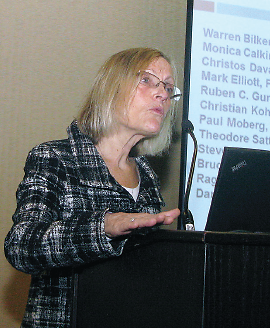Early identification of psychosis should be a priority, made possible by a growing research base that is bringing together genetic, neurodevelopmental, and behavioral observations to provide a picture of the unfolding psychotic process over time.
That’s what Raquel Gur, M.D., told psychiatrists at APA’s 2013 Institute on Psychiatric Services in Philadelphia. She is a professor of psychiatry and vice chair of research development in psychiatry at the University of Pennsylvania.
She noted that early identification has become a leading priority at the National Institute of Mental Health and said it should be a “national priority,” spurred in part by publicity surrounding recent incidents of gun violence that have involved mental illness. Gur outlined the challenges confronting this effort—especially the unique complexity of psychosis, its multidimensional nature, and heterogenous presentation—as well as the tools that are becoming available to meet these challenges.
The latter include the use of large “informative samples”—cohorts of individuals with at least two first-degree relatives with schizophrenia—genetic risk studies that follow individuals with a known genetic vulnerability over time, the development of structured interview tools for assessing risk, and a large and growing number of intervention programs in the United States, Europe, and Australia. Finally, she described a unique longitudinal research project in Philadelphia that is combining genetic, neurodevelopmental, neuroimaging, and behavioral data to follow a large cohort of young people.
“It is time we do it,” she said. “We need to investigate the precursors that will allow us with increased confidence to detect early [those at risk for psychosis].”
‘We Aren’t Done When We Are Born’
Gur said the effort to identify psychosis in its early developmental stages is not different from prevention strategies in other areas of medicine, noting that much clinical cardiology now involves strategies aimed at reducing stress, increasing exercise, and promoting better diet and other behavioral changes designed to reduce the risk for cardiovascular disease in individuals at risk.
“It’s no different for psychosis,” she said. “When someone presents with a risk, we cannot send them away until they meet DSM criteria for schizophrenia. So we share a common goal with medicine regarding any other disorder—namely, that we would like to prevent the consequences of a serious and complex disorder through early identification and intervention.”
But she acknowledged obstacles and challenges that are unique to psychosis. Principal among these is the stigma associated with psychiatric illness. Also, the complexity of the brain and of psychosis is uniquely daunting. She said early notions that schizophrenia may be related to a “lesion” in the brain have been discarded with the emergence of genetic and neurodevelopmental data showing instead that psychosis is a disorder of neurocircuitry.
Additionally, there are multiple risk genes and epigenetic factors—such as in-utero events—that may influence the development of psychosis. These are all influenced developmentally over time by an individual’s environmental experience. “Experience matters,” Gur said. “The brain continues to develop and change throughout life. We are not done when we are born.”
It is this etiological complexity and neurodevelopmental evolution that accounts for the “rich phenotypic expression” of schizophrenia, she said. “It’s fascinating; every patient is an individual…. When we write in a clinical note that the patient has ‘delusions,’ it’s a code for communicating with other clinicians. But it doesn’t capture the richness and complexity that differentiate one individual from another.”
She noted that evidence has accumulated showing that people who later develop acute psychosis began to deviate from developmental norms as early as age 10. “So the train toward psychosis leaves the station early, and we are trying to capture it before it derails,” Gur said. “When it derails, it’s too late. So what we are looking for are signs to help us identify people at risk and get them as close to the developmental curve as possible.”
To meet these challenges, instruments and research methods have been developed at academic medical centers to help “dissect” psychosis. These include a number of population-based studies using very large cohorts of patients, typically in European countries with relatively stable, homogenous populations and large databanks.
First-Degree Relatives Studied
There are also smaller studies looking at “informative samples”—cohorts with two or more individuals having first-degree relatives with schizophrenia; she said some 50 families in Pennsylvania meeting this criterion are being followed.
Additionally, there are individuals with a known specific genetic risk factor that can be similarly followed. Gur noted that the “22Q11.2 deletion syndrome” is known to account for multiple medical problems, including schizophrenia. “In terms of presentation and response to treatment, they are no different from other people with schizophrenia, but because we know the risk, we can follow them from an early age, and we can see the psychotic process unfold.”
Moreover, many prevention programs have grown up in North America, Europe, and Australia using behavioral interventions for youth deemed to be at ultra-high risk for psychosis. A Structured Interview for Prodromal Symptoms (SIPS) has been developed by Thomas McGlashan, M.D., and colleagues at Yale that has proven effective in identifying ultra-high-risk individuals.
Ultimately, Gur said, research efforts at academic medical centers need to be translated into community settings. She described an extraordinary initiative—the Philadelphia Neurodevelopmental Cohort—that seeks to describe how genetics impact trajectories of brain development and cognitive functioning in adolescence and understand how abnormal trajectories of development are associated with psychiatric symptomatology.
Nearly 10,000 youth aged 8 to 21 presenting at Children’s Hospital of Philadelphia for nonpsychiatric reasons have received a comprehensive genetic, psychiatric, and cognitive assessment, with a subsample of these participants receiving multimodal neuroimaging.
Participants received a one-hour computerized neurocognitive battery to evaluate a broad range of cognitive domains: executive control and mental flexibility, attention, working memory, episodic memory, verbal reasoning, nonverbal reasoning, spatial processing, social cognition, and sensorimotor and motor speed. Psychopathology was assessed using a computerized structured screener known as GOASSESS that was developed from a modified version of the Kiddie-Schedule for Affective Disorders and Schizophrenia.
Gur said such research will in time yield more positive predictive information about psychosis risk. “If we can understand behavior and how it is linked to the brain and to the processes of genetic vulnerability, we can put it all together and come up with treatments,” she said.
Gur concluded by saying that families and young people at risk often endorse symptoms of subthreshold psychosis and express a desire to participate in research and treatment. “They know that something is going on, and their ability to talk about it with someone is a relief, when we can say as clinicians, ‘We understand what you are going through.’
“We have the tools [for early identification and intervention],” she said. “They are not perfect, but the effort is important and doable.” ■

